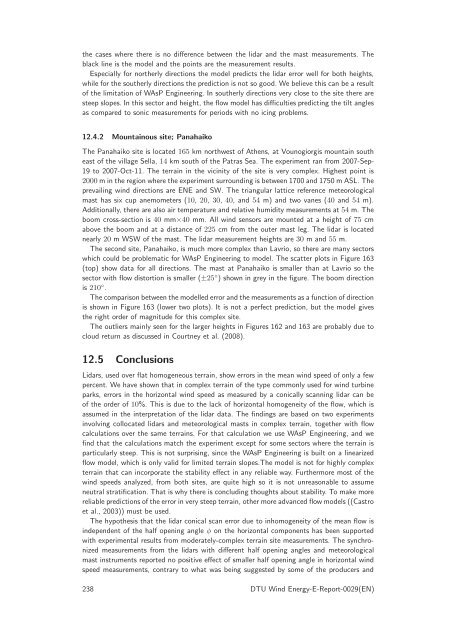Publishers version - DTU Orbit
Publishers version - DTU Orbit
Publishers version - DTU Orbit
Create successful ePaper yourself
Turn your PDF publications into a flip-book with our unique Google optimized e-Paper software.
the cases where there is no difference between the lidar and the mast measurements. The<br />
black line is the model and the points are the measurement results.<br />
Especially for northerly directions the model predicts the lidar error well for both heights,<br />
while for the southerly directions the prediction is not so good. We believe this can be a result<br />
of the limitation of WAsP Engineering. In southerly directions very close to the site there are<br />
steep slopes. In this sector and height, the flow model has difficulties predicting the tilt angles<br />
as compared to sonic measurements for periods with no icing problems.<br />
12.4.2 Mountainous site; Panahaiko<br />
The Panahaiko site is located 165 km northwest of Athens, at Vounogiorgis mountain south<br />
east of the village Sella, 14 km south of the Patras Sea. The experiment ran from 2007-Sep-<br />
19 to 2007-Oct-11. The terrain in the vicinity of the site is very complex. Highest point is<br />
2000mintheregionwheretheexperimentsurroundingisbetween1700and1750mASL. The<br />
prevailing wind directions are ENE and SW. The triangular lattice reference meteorological<br />
mast has six cup anemometers (10, 20, 30, 40, and 54 m) and two vanes (40 and 54 m).<br />
Additionally, there are also air temperature and relative humidity measurements at 54 m. The<br />
boom cross-section is 40 mm×40 mm. All wind sensors are mounted at a height of 75 cm<br />
above the boom and at a distance of 225 cm from the outer mast leg. The lidar is located<br />
nearly 20 m WSW of the mast. The lidar measurement heights are 30 m and 55 m.<br />
The second site, Panahaiko, is much more complex than Lavrio, so there are many sectors<br />
which could be problematic for WAsP Engineering to model. The scatter plots in Figure 163<br />
(top) show data for all directions. The mast at Panahaiko is smaller than at Lavrio so the<br />
sector with flow distortion is smaller (±25 ◦ ) shown in grey in the figure. The boom direction<br />
is 210 ◦ .<br />
Thecomparisonbetweenthemodellederrorandthemeasurementsasafunctionofdirection<br />
is shown in Figure 163 (lower two plots). It is not a perfect prediction, but the model gives<br />
the right order of magnitude for this complex site.<br />
The outliers mainly seen for the larger heights in Figures 162 and 163 are probably due to<br />
cloud return as discussed in Courtney et al. (2008).<br />
12.5 Conclusions<br />
Lidars, used over flat homogeneous terrain, show errors in the mean wind speed of only a few<br />
percent. We have shown that in complex terrain of the type commonly used for wind turbine<br />
parks, errors in the horizontal wind speed as measured by a conically scanning lidar can be<br />
of the order of 10%. This is due to the lack of horizontal homogeneity of the flow, which is<br />
assumed in the interpretation of the lidar data. The findings are based on two experiments<br />
involving collocated lidars and meteorological masts in complex terrain, together with flow<br />
calculations over the same terrains. For that calculation we use WAsP Engineering, and we<br />
find that the calculations match the experiment except for some sectors where the terrain is<br />
particularly steep. This is not surprising, since the WAsP Engineering is built on a linearized<br />
flow model, which is only valid for limited terrain slopes.The model is not for highly complex<br />
terrain that can incorporate the stability effect in any reliable way. Furthermore most of the<br />
wind speeds analyzed, from both sites, are quite high so it is not unreasonable to assume<br />
neutral stratification. That is why there is concluding thoughts about stability. To make more<br />
reliablepredictionsoftheerrorinverysteepterrain,othermoreadvancedflowmodels((Castro<br />
et al., 2003)) must be used.<br />
The hypothesis that the lidar conical scan error due to inhomogeneity of the mean flow is<br />
independent of the half opening angle φ on the horizontal components has been supported<br />
with experimental results from moderately-complex terrain site measurements. The synchronized<br />
measurements from the lidars with different half opening angles and meteorological<br />
mast instruments reported no positive effect of smaller half opening angle in horizontal wind<br />
speed measurements, contrary to what was being suggested by some of the producers and<br />
238 <strong>DTU</strong> Wind Energy-E-Report-0029(EN)

















